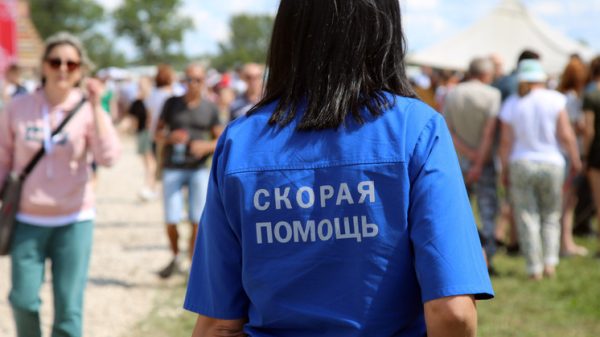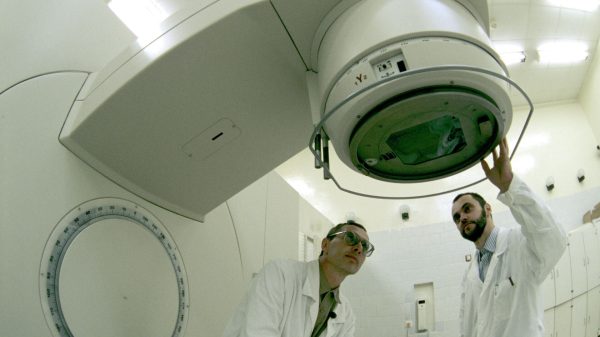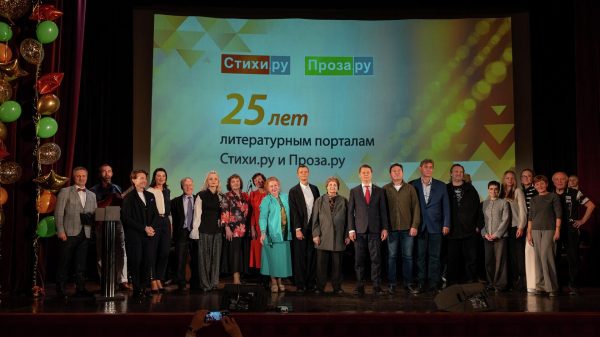For weeks, fans had been worrying about Marina Joyce. The 19-year-old beauty-YouTuber didn’t seem herself. Her once upbeat and quirky personality had shifted dramatically: her videos were filled with silent stares and shifty off-camera glances. On 8 July, viewers noticed a gun in the background of her latest make-up tutorial. They began talking about how she appeared frightened and distressed.
A video from 8 July where viewers noticed a gun in the background
Exactly two weeks later, Marina posted another video. Commenters were quick to point out the sprawling green bruises covering the back of her arms. They noticed that her eyes were wide and unblinking, and a finger briefly directed her from the side of the frame. Most worryingly of all, 13 seconds into the video, the teenager seemed to whisper the words “Help me”.
Two weeks later, another video contained elements that worried commenters
It took four days for the wider internet to fall into a frenzy. After a fan compiled a list of their concerns on justpaste.it – a site dedicated to sharing blocks of text easily – the hashtag #SaveMarinaJoyce became the number one trending topic worldwide. When Marina then tried to arrange a 6:30am meet up with her fans, some speculated she was involved in a trap set by Isis. Thousands of teenagers revealed that they couldn’t sleep and were shaking from their belief that Marina had been kidnapped or was being held hostage. More than 60 people tweeted that it had caused them to have an anxiety or panic attack. The mood was one of hysteria.
‘The more I believed she was being abused, the more I got anxious’
“It felt like every wall came towards me and I couldn’t get out,” says Usha Vandermaelen, a 19-year-old student from Belgium, who suffered a panic attack while following the hashtag and watching Marina’s videos. “I had to pause the videos to keep myself together and not burst out crying. I had to ask my mother to calm me down, it lasted a few hours.”
Vandermaelen has been diagnosed with social anxiety disorder, and says she suffers attacks if “something huge happens like this” or if one of her idols dies. She says that for the two days that #SaveMarinaJoyce trended, she only had three-and-a-half hours’ sleep.
How it feels to be at the centre of an internet kidnapping conspiracy
Read more
“It made me feel very anxious as I felt like I had to do something to make sure the girl was safe. The more I believed there was a scary figure abusing her, the more I got anxious.”
But the problem is, there was no scary figure. There was no kidnapping. No abuse. The fears were all baseless. After “numerous” calls, the Enfield police department visited Marina in the early hours of 27 July and tweeted at 4:34AM that she was safe. Marina herself also tweeted that she was “TOTALLY fine”.
Enfield MPS
(@MPSEnfield)
Officers have visited YouTube user Marina Joyce. She is safe and well. #ETeam #savemarinajoyce
July 27, 2016
Despite this, the hysteria didn’t abate.
“This phenomenon is not entirely new,” says Stefan Stieglitz, a professor of professional communication in electronic media at the University of Duisburg-Essen. “If people get new information that is in contrast to what they believe then they tend to neglect this new information for as long as possible.”
In a 2013, paper on how emotions diffuse across social media, Steiglitz discovered that emotionally charged messages tend to be retweeted more often and more quickly. “Emotion can be transmitted via computer-mediated communication and can go viral,” he says. “This is called emotional contagion.”
Emotional contagion isn’t new either. It’s an age-old phenomenon whereby an individual’s emotions trigger similar emotions in others. Historically this has led to outbreaks of mass hysteria such as the Salem witch trials, but on the internet the potential for hysteria to spread is even greater.
“There is a pressure on people to react instantly as this can enhance a person’s popularity within a group,” says Jacqui Taylor, a chartered psychologist and cyberpscyhology researcher and lecturer at the University of Bournemouth. “This pressure exacerbates groupthink as there is no time to check facts or consider other explanations. If people think others have similar views or emotions then hysteria can result as they confirm the accuracy of each other, and so emotions spiral.”
But the users of #SaveMarinaJoyce didn’t just feel panic and hysteria. By playing detective, those who shared theories and screenshots were allowed to feel another, very different but equally contagious emotion. Pride.
“In all areas of our lives we engage in a process called social comparison,” says Alison Attrill, a senior lecturer of Cyberpsychology Research at the University of Wolverhampton. “If a person compares themselves to someone who they perceive to be better able and then they beat them in solving a case like this, it makes them feel good about themselves. Social media makes this type of behaviour affordable and accessible. The user doesn’t need a lengthy education to become an investigator, it’s all at their fingertips.”
r/FindBostonBombers
This isn’t the first time something like this has happened. After the Boston Marathon bombing in April 2013, users of the news and networking site Reddit banded together to try to identify the bomber using photographs, audio from police scanners, and CCTV footage. Just like with Marina Joyce, those involved felt an odd mix of both panic and pride.
“Being on the West Coast, I was far away from the hysteria on the ground, but I was caught up online,” a 38-year-old Portland Redditor involved in trying to find the Boston bomber tells me via Reddit’s messaging service.
“I think there was a frenzy in people wanting to help somehow. Terrorism is usually ‘random’ and you cannot protect yourself. I think jumping online to track these assholes gives people a sense of control,” writes the Redditor, who wishes to be identified only as ‘Trey’.
It is clear that most of the people who wanted to #SaveMarinaJoyce and r/FindBostonBombers were genuinely trying to help. Trey repeatedly writes how amazing it was that people didn’t have to rely on news outlets, and could discover and share things for themselves. At the time, other Redditors posted about how helpful it was to hear immediate information when they had family nearby. Still, Reddit didn’t make history for how helpful they were in this case.
Sunil Tripathi was found dead on April 23 2013, eight days after being wrongly accused by Reddit of being the Boston bomber. The 22-year-old American student had been missing for a month prior, and had likely killed himself before the accusations started. But for the four hours that Sunil was wrongly identified by the internet as suspect number 2 in the bombings, the Tripathi family went through hell.
Between the hours of 3am and 4.15am on 19 April , Sunil’s sister Sangeeta’s phone rang 58 times. By 6:45am, the family had received hundreds of threatening and anti-Islamic messages, despite the fact they are not Muslim. The Tripathis had been doxxed – meaning their private information had been published on the internet – as a result of the online hysteria.
“There was a minority of voices being the voice of reason about not doxxing people,” writes Trey. “Which makes sense, but I think we’re so sick of this terrorist stuff … people were like … I don’t care … let’s find these fuckers. A little Donald-Trump style frenzy. ‘Let’s get ‘em’!”
If it sounds remarkably like a witch hunt, that’s because it is.
“This sort of thing has always happened in human history,” says John Suler, one of the founders of cyberpsychology and the author of Psychology of the Digital Age: Humans Become Electric, “but cyberspace speeds up the process because these like-minded people can easily find each other and easily target someone.”
Which brings us back to Marina Joyce. After the YouTuber posted a video claiming the whole debacle was a “publicity stunt by [her] viewers, not by me”, social media users dramatically turned on her. She too became the victim of a witch hunt, as Twitter rapidly decided to change tack and #BoycottMarinaJoyce. “Hope u lose all ur followers u ugly bimbo,” tweeted one user, who claimed she had kept him up all night worrying. The tide had turned direction, but the hysteria remained.
Aaron Kompton
(@AaronRamirez14)
#boycottmarinajoyce waiting for an apology bitch u kept me all night for ur bullshit!!! Hope u lose all ur followers u ugly bimbo
July 28, 2016
“Being part of a group empowers a person,” says Suler. “The can also result in ‘deindividuation’ – the person goes a long with the crowd and feels less responsible, personally, for the actions they take with the crowd.” The delete button – that came in handy for the many journalists who also accused Sunil Tripathi of being the Boston bomber – also allows users to if not feel, at least appear, less responsible.
The implications of this are huge. We live in a world where it’s easier than ever for hysteria to spread, easier than ever to uncover personal information in order to target an individual, and easier than ever to remove ourselves from blame.
Truth, lies and the internet
Beyond the Tripathis and Marina Joyce, many people have felt the effects of these phenomena.
Vereender Jubbal, a Canadian Sikh man, was wrongly identified by social media as the perpetrator of both the Paris and Nice attacks. Tony, a 62-year-old Runescape player was wrongly accused of being a paedophile by the YouTuber Keemstar – cries about the death threats he received in one of the most throat-achingly sad videos on the internet. A teenager in Emden, Germany, was accused in a Facebook post by another teenager of being responsible for the the death of an 11-year-old girl [link in German]. As many as 50 people demanded the police hand him over to them – even though he was innocent.
Tony received death threats after being wrong accused of being a paedophile
The problem becomes ever greater due to one of the other major prevailing habits of the internet: making stuff up. During the Marina Joyce case, many users shared Photoshopped images claiming she had written ‘help me’ on a box under her bed, or that there was the shadow of a man in her eye.
“There are two potential explanations for this type of behaviour,” says Taylor. “Firstly, technology depersonalises interactions and people do not consider how their actions will affect others. Other explanations relate to the personality – for example, narcissism – or other underlying psychological problems of individuals.”
But the issue isn’t really that bad people do bad things. Fake pictures and facts wouldn’t have nearly the same effect if it wasn’t for the multitude of well-intentioned people who share them. Truth, Lies, and the Internet is a 2011 report that examined the ability of young Britons to critically evaluate online information. “Our research shows … that many young people are not careful, discerning users of the internet,” concluded the co-authors, Jamie Bartlett and Carl Miller.
“Much of the internet has now formed islands of segregated opinion rather than flows of dissenting argument and engagement,” reads the report. “Within these often fairly closed communities, the two-way flow of information doesn’t happen.” The fact that social media users are neither confronted with, nor seek out, the truth only exacerbates hysterical reactions.
As well as emotional contagion, a feeling of belonging, witch-hunting, and the effect of fake images, there was one last factor at play in the Marina Joyce scandal. Marina is a YouTuber and as such, a social influencer. Marketers have long since cottoned on to the power YouTubers have over their fans, as their unique celebrity rests on the fact that viewers consider them their friends.
“Fans of popular media often develop parasocial interactions, ie individuals believe they have a personal relationship with a media character where none exists,” says Bradley Okdie, an assistant professor at the University of Ohio who studies how technology affects the way humans interact.
“Parasocial relationships are likely stronger with YouTubers as they appear closer to their fans compared to characters in a movie or on television. Thus, one could imagine that those in parasocial relationships might react similarly to those in close friendships when they feel their relationship partner is in danger.”
In a social media playground that’s ripe for hysteria, it may ultimately be people like Vandermaelen and the many other teens who lost sleep over Joyce who suffer the most. Joyce, though she didn’t set out to use the situation to her advantage, now has more than 1.5 million more subscribers than she did last week. Her YouTube account goes from strength to strength.
• Is it safe to turn your children into YouTube stars?
• _9MOTHER9HORSE9EYES9: the mysterious tale terrifying Reddit

























































Свежие комментарии